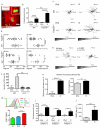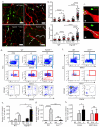Immune complexes stimulate CCR7-dependent dendritic cell migration to lymph nodes
- PMID: 25384086
- PMCID: PMC4283039
- DOI: 10.1038/nm.3709
Immune complexes stimulate CCR7-dependent dendritic cell migration to lymph nodes
Abstract
Antibodies are critical for defense against a variety of microbes, but they may also be pathogenic in some autoimmune diseases. Many effector functions of antibodies are mediated by Fcγ receptors (FcγRs), which are found on most immune cells, including dendritic cells (DCs)-important antigen-presenting cells that play a central role in inducing antigen-specific tolerance or immunity. Following antigen acquisition in peripheral tissues, DCs migrate to draining lymph nodes via the lymphatics to present antigen to T cells. Here we demonstrate that FcγR engagement by IgG immune complexes (ICs) stimulates DC migration from peripheral tissues to the paracortex of draining lymph nodes. In vitro, IC-stimulated mouse and human DCs showed greater directional migration in a chemokine (C-C) ligand 19 (CCL19) gradient and increased chemokine (C-C) receptor 7 (CCR7) expression. Using intravital two-photon microscopy, we observed that local administration of IC resulted in dermal DC mobilization. We confirmed that dermal DC migration to lymph nodes depended on CCR7 and increased in the absence of the inhibitory receptor FcγRIIB. These observations have relevance to autoimmunity because autoantibody-containing serum from humans with systemic lupus erythematosus (SLE) and from a mouse model of SLE also increased dermal DC migration in vivo, suggesting that this process may occur in lupus, potentially driving the inappropriate localization of autoantigen-bearing DCs.
Figures




References
-
- Banchereau J, Steinman RM. Dendritic cells and the control of immunity. Nature. 1998;392:245–252. - PubMed
-
- Steinman RM. Decisions about dendritic cells: past, present, and future. Annu Rev Immunol. 2012;30:1–22. - PubMed
-
- Krause RM, Dimmock NJ, Morens DM. Summary of antibody workshop: The Role of Humoral Immunity in the Treatment and Prevention of Emerging and Extant Infectious Diseases. J Infect Dis. 1997;176:549–559. - PubMed
-
- Joller N, Weber SS, Oxenius A. Antibody-Fc receptor interactions in protection against intracellular pathogens. Eur J Immunol. 2011;41:889–897. - PubMed
-
- Ravetch JV, Bolland S. IgG Fc receptors. Annu Rev Immunol. 2001;19:275–290. - PubMed
Supplementary references
-
- Schaefer BC, Schaefer ML, Kappler JW, Marrack P, Kedl RM. Observation of antigen-dependent CD8+ T-cell/ dendritic cell interactions in vivo. Cell Immunol. 2001;214:110–122. - PubMed
-
- Lindquist RL, et al. Visualizing dendritic cell networks in vivo. Nat Immunol. 2004;5:1243–1250. - PubMed
-
- Lammermann T, et al. Rapid leukocyte migration by integrin-independent flowing and squeezing. Nature. 2008;453:51–55. - PubMed
-
- Bowden ET, Coopman PJ, Mueller SC. Invadopodia: unique methods for measurement of extracellular matrix degradation in vitro. Methods Cell Biol. 2001;63:613–627. - PubMed
Publication types
MeSH terms
Substances
Grants and funding
LinkOut - more resources
Full Text Sources
Other Literature Sources
Medical
Molecular Biology Databases

